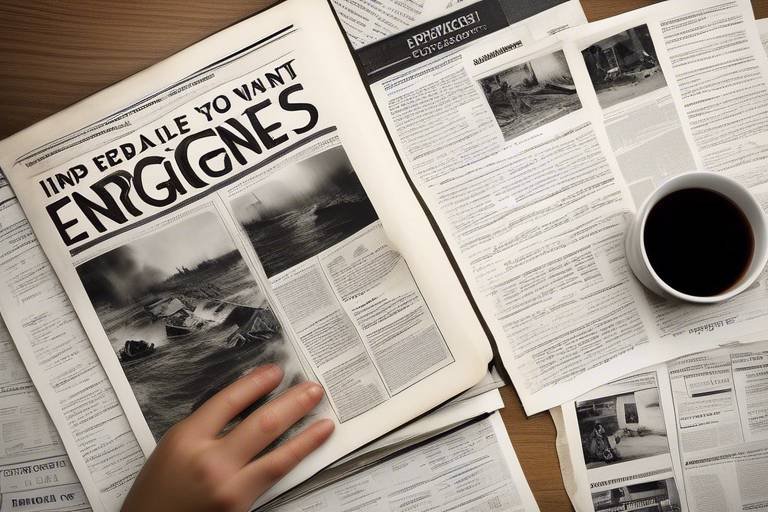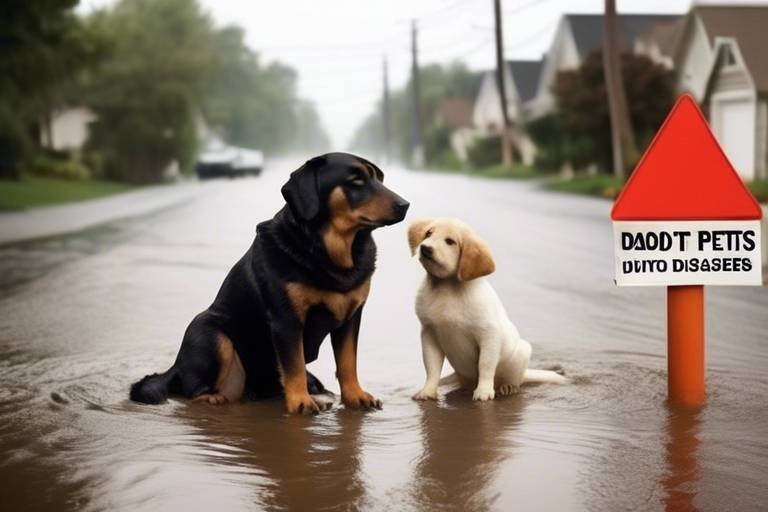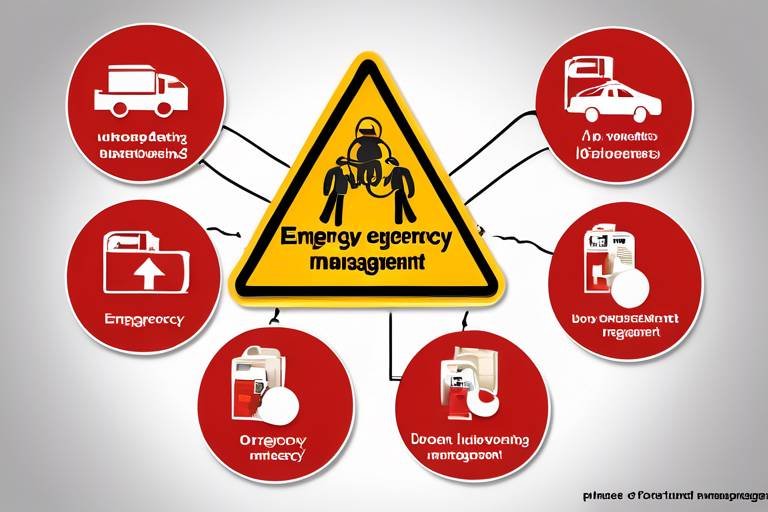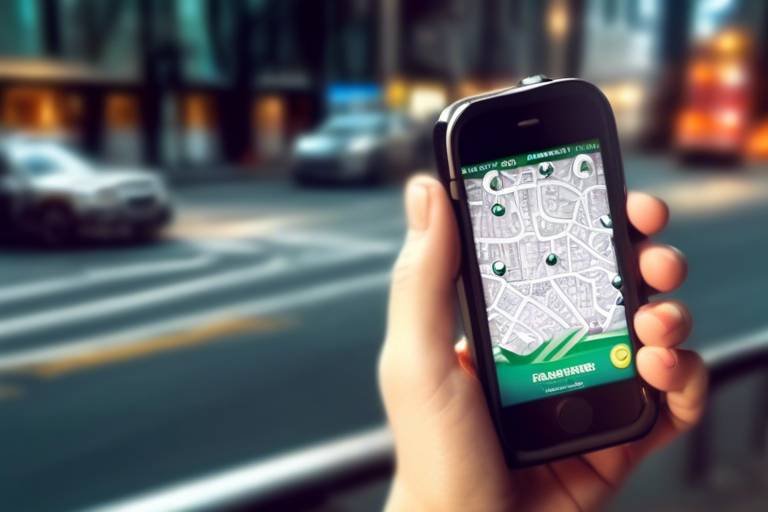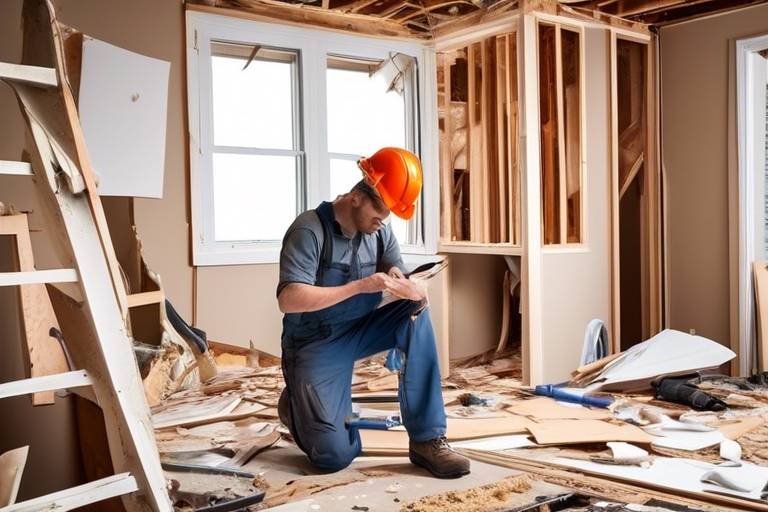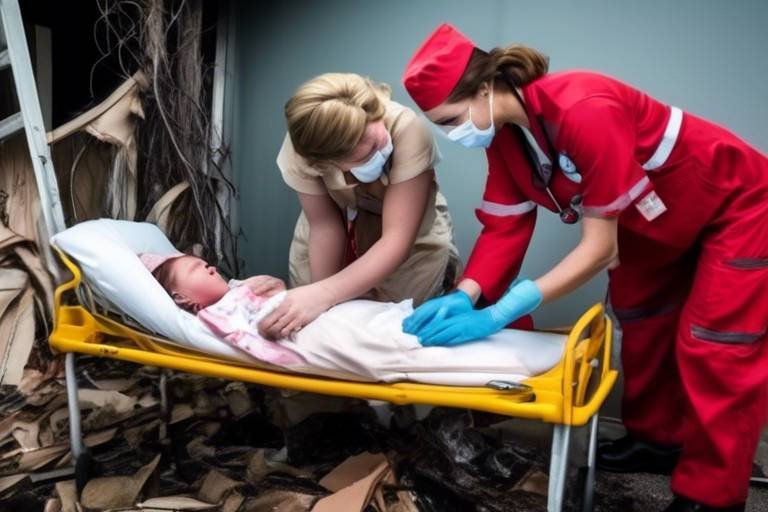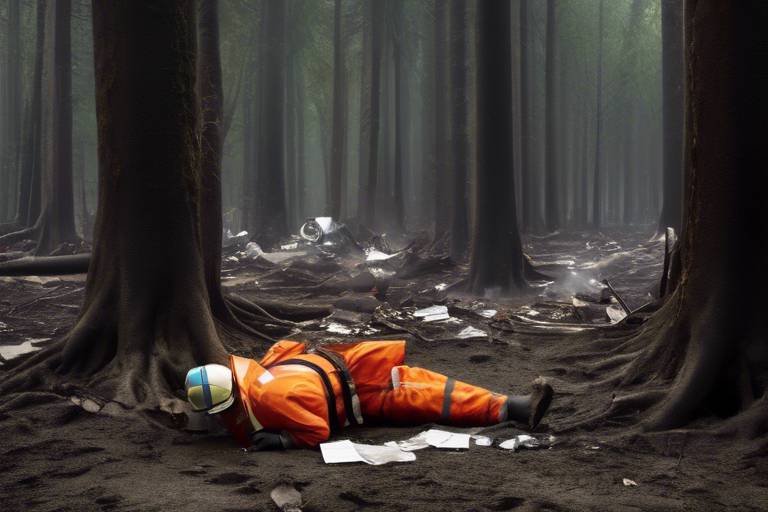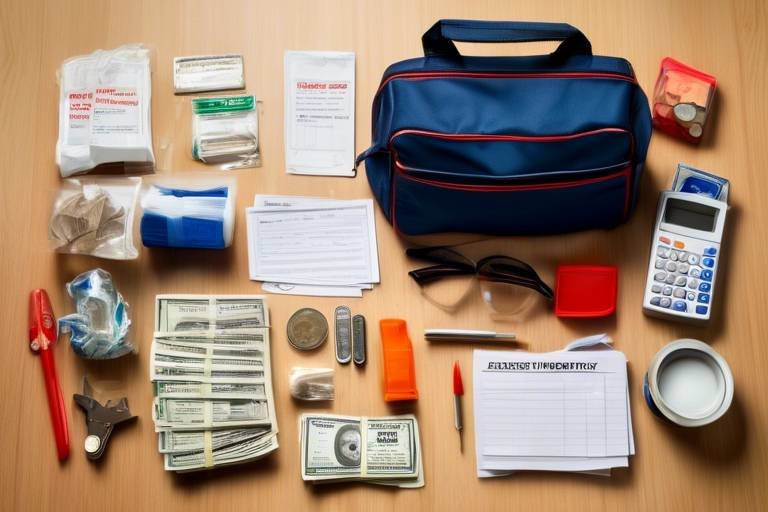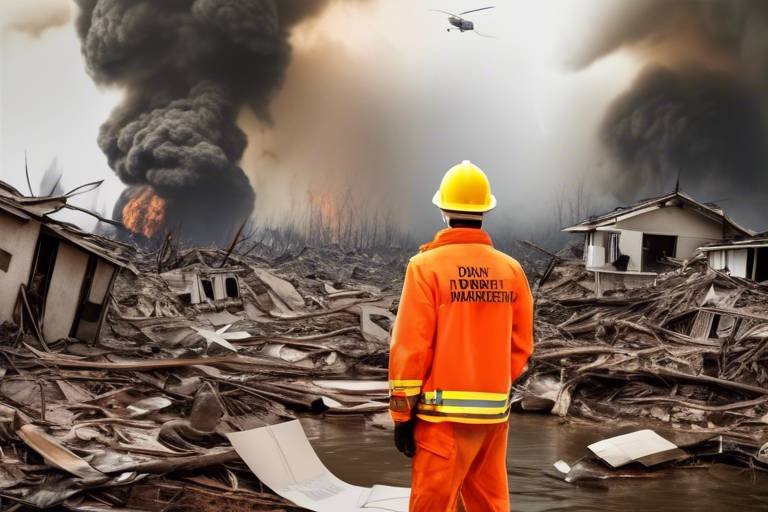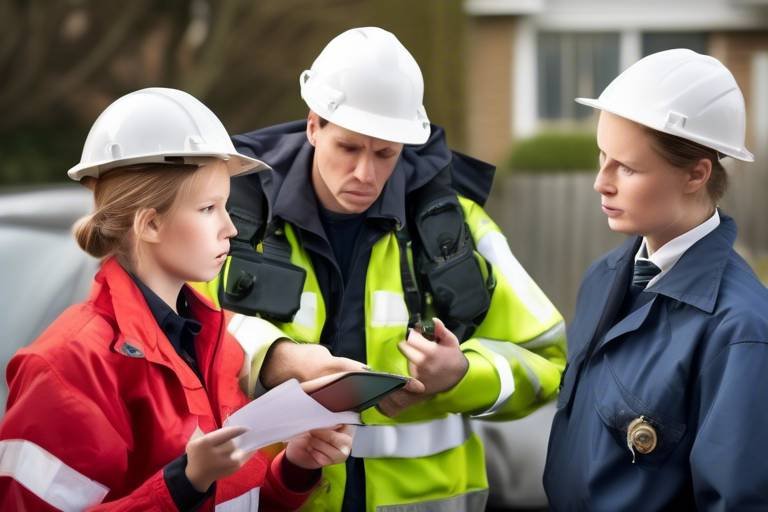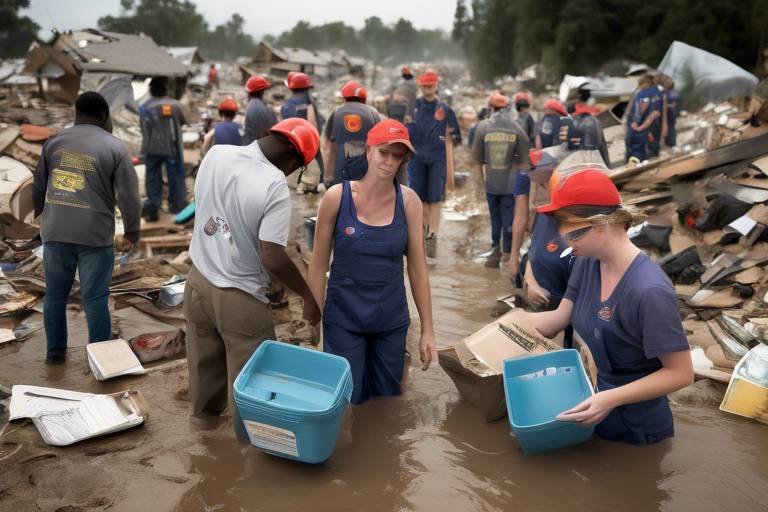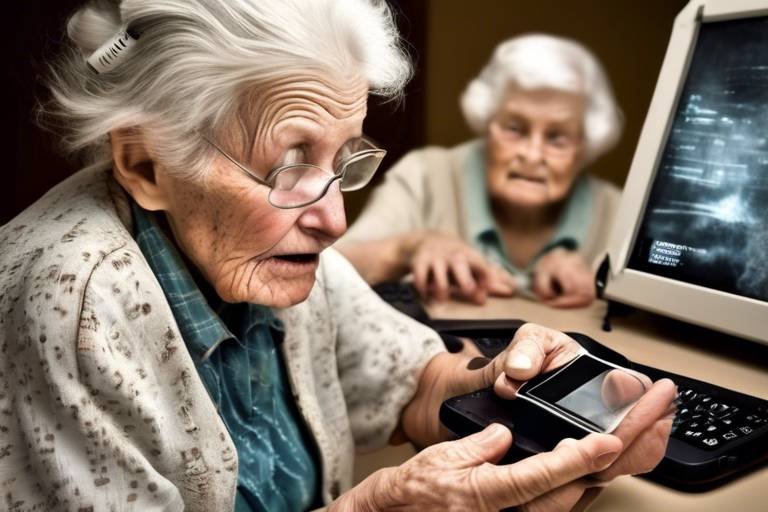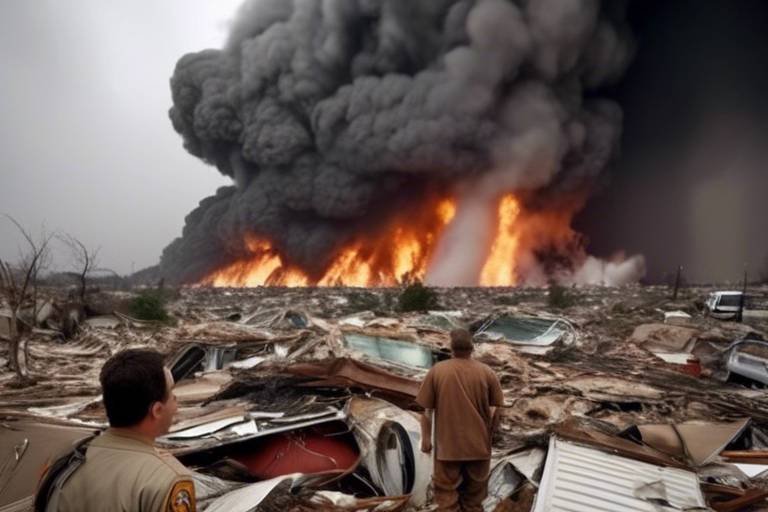Finding Reliable Sources of Information During Emergencies
In today's fast-paced world, the ability to access reliable information during emergencies is more critical than ever. When disaster strikes—be it a natural calamity like a hurricane or a man-made crisis—having the right information can mean the difference between safety and chaos. Imagine being in a situation where every second counts, and you need to make quick decisions. The last thing you want is to be misled by false information or rumors that can lead to panic and confusion. This article delves into the significance of finding trustworthy sources during such times and offers practical advice on how to navigate the information landscape effectively.
Why is reliable information so crucial during emergencies? Well, think of it as your lifeline. In moments of crisis, people often face overwhelming stress and uncertainty. Accurate information empowers individuals to make informed decisions, which can significantly impact their safety and well-being. For instance, knowing the safest evacuation routes, understanding the nature of the threat, or being aware of available resources can save lives and conserve critical resources. Furthermore, misinformation can exacerbate fear and lead to poor decision-making. Thus, having access to credible information is not just a matter of convenience; it is a fundamental necessity that can influence the outcome of a situation.
Recognizing which sources are credible is essential. Not all information is created equal, and distinguishing between reliable and unreliable sources can be challenging, especially in the heat of the moment. Trusted information providers typically exhibit certain characteristics:
- Authority: They have expertise or official status in their field.
- Accuracy: Their information is based on verified facts.
- Timeliness: They provide up-to-date information relevant to the current situation.
- Transparency: They are open about their sources and methods.
Some of the most reliable sources include government agencies, reputable news outlets, and established organizations dedicated to emergency management.
Government agencies often serve as the backbone of information dissemination during emergencies. They have the resources, authority, and responsibility to provide timely and accurate updates. Key agencies include:
- The Federal Emergency Management Agency (FEMA): Provides information on disaster preparedness and recovery.
- Centers for Disease Control and Prevention (CDC): Offers health-related guidance during public health emergencies.
- Local Emergency Management Offices: Focus on community-specific needs and updates.
These agencies play a vital role in ensuring that the public receives the necessary information to respond effectively to emergencies.
Understanding the difference between local and national agencies can significantly enhance your information-gathering efforts. While national agencies provide a broader context, local agencies often have more relevant and immediate information tailored to your specific area. For example, during a natural disaster, local agencies might issue evacuation orders or shelter locations that national agencies may not cover. Thus, it is crucial to stay informed about both levels of information to ensure comprehensive situational awareness.
Organizations dedicated to emergency management play a vital role in coordinating responses and providing reliable information. These organizations often collaborate with government entities and community groups to ensure a unified response. They offer resources such as:
- Emergency preparedness training
- Public awareness campaigns
- Coordination of volunteer efforts during crises
Connecting with these organizations can provide valuable insights and support during emergencies.
Quality news outlets are critical during emergencies. They serve as a platform for disseminating important updates, but not all news sources are created equal. To assess the credibility of news sources, consider the following:
- Check the outlet's reputation and history.
- Look for articles that cite credible sources.
- Cross-reference information with other reputable outlets.
By doing so, you can ensure that you are receiving accurate and timely information during emergencies.
Social media can be a double-edged sword during emergencies. While it can provide real-time updates, it is also a breeding ground for misinformation. Navigating social platforms for accurate information requires a cautious approach. Following official accounts of organizations and officials can help you stay updated with reliable information. However, it is equally important to recognize misinformation and verify claims before sharing or acting on them.
Following verified accounts of organizations and officials can provide timely updates. These accounts often share crucial information about safety guidelines, evacuation routes, and emergency resources. It's essential to distinguish between official and unofficial sources to avoid falling into the trap of misleading information.
Misinformation can spread rapidly on social media, leading to confusion and panic. Some common signs of false information include:
- Exaggerated claims without credible sources
- Posts that evoke strong emotional responses
- Information that lacks context or seems too good (or bad) to be true
To combat misinformation, always verify claims through trusted sources before sharing or acting on them.
Local community resources can be invaluable during emergencies. Engaging with community support networks and local information hubs can provide reliable updates and assistance when you need it most. Many communities have established systems to keep residents informed and safe.
Neighborhood watch programs often provide timely alerts and community-specific information. These programs are a great way to stay connected with your neighbors and receive updates about local emergencies. Getting involved can not only help you stay informed but also foster a sense of community responsibility during crises.
Nonprofit organizations often assist during crises by providing resources and information. They can offer everything from food and shelter to emotional support and guidance. Connecting with these groups can provide essential assistance and help you navigate the challenges posed by emergencies.
Q: How can I verify information during an emergency?
A: Always check multiple trusted sources, such as government websites and reputable news outlets, before acting on information.
Q: What should I do if I encounter misinformation?
A: Report it to the platform and share accurate information from credible sources to help combat the spread of false claims.
Q: How can I stay updated during an emergency?
A: Follow official accounts on social media, sign up for local alerts, and keep in touch with community resources.

The Importance of Reliable Information
In times of crisis, the value of reliable information cannot be overstated. Imagine being in the midst of a natural disaster, unsure of which way to turn or what to do next. The difference between chaos and calm often hinges on having access to trustworthy information. Reliable sources enable individuals to make informed decisions, which can ultimately save lives and resources. When emergencies strike, misinformation can spread like wildfire, leading to panic and confusion. Thus, understanding the importance of reliable information is crucial for effective crisis management.
During emergencies, people face a myriad of choices and challenges. From evacuation routes to safety protocols, each decision can carry significant weight. By relying on accurate and timely information, individuals can navigate these challenges more effectively. For instance, knowing the correct evacuation routes can mean the difference between safety and danger. Moreover, reliable information helps communities respond cohesively, ensuring that everyone is on the same page regarding safety measures and available resources.
It's essential to recognize that not all information is created equal. In the age of digital communication, anyone can publish content online, leading to a flood of unverified claims. This is where the importance of identifying trusted sources comes into play. Reliable information typically comes from established organizations, government agencies, and reputable news outlets. These sources have a responsibility to provide accurate updates and guidelines during emergencies. By prioritizing information from these trusted providers, individuals can reduce the risk of falling victim to rumors and false narratives.
Furthermore, the impact of reliable information extends beyond individual safety. It fosters a sense of community resilience. When people have access to accurate updates, they can support one another more effectively. This interconnectedness is vital during emergencies, where resources may be scarce, and coordination is key. For instance, community leaders can utilize reliable information to organize relief efforts, ensuring that aid reaches those who need it most. In this way, reliable information not only empowers individuals but also strengthens the fabric of the community as a whole.
Ultimately, the importance of reliable information during emergencies cannot be emphasized enough. It serves as a lifeline, guiding individuals and communities through uncertain times. By recognizing trusted sources and prioritizing accurate updates, we can equip ourselves with the knowledge needed to respond effectively to crises. So, the next time you find yourself in an emergency situation, remember that the right information can be your greatest ally.

Identifying Trusted Sources
In a world where information flows faster than a wildfire, knowing how to identify trusted sources is like having a compass in the midst of a storm. During emergencies, the right information can mean the difference between safety and chaos. So, how do you sift through the noise and find the nuggets of truth? First off, it's essential to understand the characteristics that define credible information providers. Reliable sources typically exhibit the following traits:
- Transparency: Trusted sources are open about their information, including where it comes from and how it was gathered.
- Expertise: Look for organizations or individuals with relevant qualifications and experience in the field, whether it’s health, safety, or crisis management.
- Accountability: Credible sources are willing to correct misinformation and take responsibility for the information they disseminate.
- Timeliness: In emergencies, the speed of information is crucial. Reliable sources provide updates promptly.
Now, let’s dive deeper into specific types of trusted sources that you can rely on during emergencies. One of the most significant categories is government agencies. These organizations are often at the forefront of crisis management, providing updates that are not only timely but also accurate. For instance, the Federal Emergency Management Agency (FEMA) in the United States plays a pivotal role in coordinating responses and disseminating vital information during disasters.
Government agencies are your frontline warriors when it comes to reliable information during emergencies. They typically have access to the latest data and can provide safety guidelines that are crucial for public welfare. Each agency has its own area of expertise, which means you can find specific information tailored to your needs. For example, the Centers for Disease Control and Prevention (CDC) offers health-related guidelines during health crises, while the National Weather Service (NWS) provides updates on severe weather conditions.
When you’re in the thick of an emergency, local agencies often have the most relevant information. They focus on immediate areas and can provide updates that are crucial for your local context. On the other hand, national agencies give you a broader picture of the situation, helping you understand how local events fit into the larger narrative. Knowing when to rely on local versus national agencies can significantly enhance your information-gathering strategy.
Organizations dedicated to emergency management are another cornerstone of reliable information. These groups work tirelessly to coordinate responses and provide resources to the public. They often have well-established communication channels and can guide you through the chaos of an emergency. For example, organizations like the Red Cross not only offer disaster relief but also provide critical information on how to prepare for various emergencies.
In conclusion, identifying trusted sources during emergencies is not just about knowing where to look; it’s about understanding what makes a source reliable. By focusing on government agencies, reputable organizations, and assessing their transparency, expertise, accountability, and timeliness, you can navigate the sea of information with confidence. Remember, in times of crisis, your ability to discern trustworthy information can lead to informed decisions that safeguard you and your loved ones.

Government Agencies
When disaster strikes, the first thing on many people's minds is how to stay safe and informed. This is where step in, acting as the backbone of reliable information dissemination during emergencies. These agencies are equipped with the necessary resources and expertise to provide timely updates, safety guidelines, and crucial information that can make a significant difference in how we respond to crises. Whether it's a natural disaster, public health emergency, or any other urgent situation, knowing which government agencies to trust is essential for navigating the chaos.
In the United States, several key agencies play pivotal roles during emergencies. For instance, the Federal Emergency Management Agency (FEMA) is known for its comprehensive disaster response strategies, while the Centers for Disease Control and Prevention (CDC) focuses on public health emergencies. Each agency has its specific area of expertise, and understanding their functions can help you access the most relevant information. Here’s a brief overview of some critical government agencies:
| Agency | Role | Website |
|---|---|---|
| FEMA | Disaster response and recovery | fema.gov |
| CDC | Public health information | cdc.gov |
| NOAA | Weather alerts and forecasts | noaa.gov |
| USDA | Agricultural emergencies | usda.gov |
Local agencies, on the other hand, often provide more immediate and relevant information tailored to specific communities. For example, your local fire department may issue alerts about wildfires or hazardous conditions in your area, while municipal health departments can provide updates on local health threats. Understanding the distinction between local and national agencies is crucial because it allows you to gather information that is not only accurate but also pertinent to your immediate surroundings. In times of crisis, having access to local data can be the difference between safety and danger.
Moreover, emergency management organizations are invaluable during crises. These organizations work diligently to coordinate responses, ensuring that resources are allocated efficiently and that communities receive the support they need. They often collaborate with various government agencies to provide a unified response, making it easier for the public to access essential information. By staying informed about these organizations and their resources, you can better prepare yourself and your family for any emergency situation.

Local vs. National Agencies
When it comes to emergencies, understanding the distinction between local and national agencies can significantly impact how effectively you gather and respond to information. Local agencies, such as city fire departments or county health departments, are often the first responders in any crisis. They have their fingers on the pulse of the community and can provide updates that are specifically tailored to your immediate area. For instance, if a severe weather event is approaching, local agencies will issue alerts that include evacuation routes, shelter locations, and community-specific safety tips that are vital for your well-being.
On the other hand, national agencies like the Federal Emergency Management Agency (FEMA) or the Centers for Disease Control and Prevention (CDC) provide a broader context. They offer information that is essential for understanding the larger picture of a national crisis. For example, during a pandemic, the CDC will issue guidelines that apply to the entire country, including travel restrictions and health advisories. While this information is crucial, it may not address the unique situations of your local area as precisely as local agencies do.
To illustrate the differences, consider this table:
| Aspect | Local Agencies | National Agencies |
|---|---|---|
| Focus | Community-specific issues | National-wide guidelines and policies |
| Response Time | Immediate and localized | Broader response, may take longer to implement |
| Information Type | Evacuation routes, local shelter info | Health advisories, travel restrictions |
| Examples | City Fire Department, Local Health Department | FEMA, CDC |
Ultimately, the best approach is to utilize both local and national sources of information during emergencies. By doing so, you can gain a comprehensive understanding of the situation at hand. Think of it like tuning into both a local radio station for immediate updates and a national news channel for broader context. This dual approach ensures you are well-informed and prepared to take the necessary actions to protect yourself and your loved ones.
In conclusion, while local agencies provide critical information that is relevant to your immediate environment, national agencies offer essential guidelines that help you understand how your situation fits into a larger framework. Recognizing the strengths of each type of agency can empower you to make informed decisions during emergencies.

Emergency Management Organizations
When it comes to navigating the chaos of an emergency, (EMOs) are the unsung heroes that stand at the forefront of crisis response. These organizations are dedicated to ensuring public safety and effective management of emergencies, whether they are natural disasters, pandemics, or other critical incidents. Their role is multifaceted, ranging from coordinating rescue operations to disseminating vital information to the public. Understanding their impact can significantly enhance your ability to stay informed and safe during a crisis.
One of the primary functions of EMOs is to develop and implement emergency response plans. These plans are meticulously crafted to address various scenarios, ensuring that communities are prepared for the unexpected. For instance, during a hurricane, EMOs work tirelessly to establish evacuation routes, set up shelters, and communicate safety information to residents. This proactive approach not only saves lives but also mitigates the potential for panic and confusion.
Moreover, EMOs often collaborate with local governments, non-profit organizations, and community groups to create a comprehensive support network. This collaboration is crucial in times of crisis, as it enables the pooling of resources and expertise. For example, in the aftermath of a wildfire, EMOs might partner with local nonprofits to provide food, shelter, and medical assistance to affected families. By leveraging these partnerships, they can address the immediate needs of the community while also focusing on long-term recovery efforts.
Additionally, many EMOs provide educational resources and training programs to help individuals and communities prepare for emergencies. These programs may include workshops on first aid, disaster preparedness, and response strategies. By empowering citizens with knowledge, EMOs foster a culture of preparedness that can make a significant difference when disaster strikes. Imagine knowing exactly what to do when the sirens go off—this level of preparedness can transform fear into action.
To better understand the role of EMOs, here’s a quick overview of some key organizations and their responsibilities:
| Organization | Primary Focus |
|---|---|
| FEMA (Federal Emergency Management Agency) | Coordination of federal disaster response and recovery efforts. |
| Red Cross | Emergency assistance, disaster relief, and education. |
| Local Emergency Management Offices | Community-specific emergency planning and response. |
In summary, Emergency Management Organizations play a critical role in ensuring that communities are prepared for and can effectively respond to emergencies. By understanding their functions and engaging with them, you can enhance your own preparedness and contribute to a safer environment for everyone. Remember, in times of crisis, knowledge is power, and EMOs are your go-to source for reliable information and support.
- What is the role of Emergency Management Organizations? EMOs coordinate disaster response efforts, develop emergency plans, and provide public education on preparedness.
- How can I get involved with my local EMO? You can volunteer, attend community meetings, or participate in training programs offered by your local EMO.
- Where can I find information during an emergency? Trusted sources include government agencies, reputable news outlets, and official social media accounts of emergency management organizations.

Reputable News Outlets
When the world feels like it's spinning out of control during an emergency, become our lifelines to understanding what’s happening. These sources are not just vessels of information; they are the anchors that keep us grounded amidst chaos. But how do we discern which news outlets are truly reputable? It’s essential to assess their credibility based on a few key characteristics.
First and foremost, look for news organizations that have a long-standing history of journalistic integrity. These outlets often have established guidelines for reporting, which include fact-checking and editorial oversight. For instance, major networks like BBC, CNN, and Reuters are known for their commitment to accuracy and unbiased reporting. They have teams dedicated to verifying information before it reaches the public, which is crucial during emergencies when misinformation can spread like wildfire.
Another important aspect to consider is the transparency of the outlet. Reputable news sources will typically provide clear citations for their claims, linking back to original reports or official statements. This transparency allows you to verify the information independently, which is vital when every second counts. In contrast, be wary of outlets that lack clear sourcing or rely heavily on anonymous tips, as these can often lead to the spread of rumors or false information.
During emergencies, it’s also beneficial to cross-reference information from multiple sources. This practice helps to confirm the accuracy of the news you’re consuming. For example, if you hear about a natural disaster from one outlet, check other reputable sources to see if they’re reporting the same facts. This approach not only reassures you of the information’s validity but also provides a broader perspective on the situation.
Additionally, many reputable outlets have dedicated sections for emergency news, offering real-time updates and safety guidelines. These sections can be a treasure trove of information when you need to stay informed about evacuations, weather alerts, or public safety measures. Make sure to bookmark these sections or follow their social media accounts for instant access to crucial updates.
In summary, during emergencies, relying on reputable news outlets is not just a good practice; it’s a necessity. By choosing sources that prioritize accuracy, transparency, and timely updates, you equip yourself with the information needed to make informed decisions. Remember, in times of crisis, knowledge is power, and the right news outlet can be your best ally.

Utilizing Social Media Wisely
In today's digital age, social media has become a powerful tool for disseminating information, especially during emergencies. However, it can also be a breeding ground for misinformation and panic. So, how can you navigate this vast ocean of information without getting swept away by falsehoods? The key is to use social media wisely, ensuring that you’re getting accurate updates while avoiding the pitfalls of unreliable sources.
First off, it's essential to follow official accounts of organizations and officials who are responsible for emergency management. These verified accounts often provide timely updates, safety guidelines, and crucial information that can help you make informed decisions. Think of them as your trusted lifeline during a stormy sea of information. It's like having a lighthouse guiding you safely to shore amidst the chaos of waves crashing around you.
But how do you distinguish between official and unofficial sources? This is where a little bit of critical thinking comes into play. Look for blue verification checkmarks on platforms like Twitter and Facebook, which indicate that the account is authentic. Additionally, check the account's follower count and engagement levels; official accounts typically have a significant following and active engagement from the community.
While following these accounts, it’s equally important to be vigilant about recognizing misinformation. Misinformation can spread like wildfire on social media, often causing unnecessary panic. So, how can you spot it? Here are some common signs:
- Emotional Language: Be wary of posts that use overly dramatic language or evoke strong emotions.
- Lack of Sources: If a post claims something shocking but doesn’t cite any credible sources, it’s likely not true.
- Unverified Claims: Always check if the information has been corroborated by reliable news outlets or official agencies.
Before sharing or acting on any information you come across, take a moment to verify the claims. Cross-reference the information with trusted news outlets or official announcements. This extra step might seem tedious, but it can make a world of difference in ensuring that you’re not contributing to the spread of false information.
In conclusion, while social media can be a valuable tool during emergencies, it’s crucial to approach it with caution. By following official accounts, recognizing misinformation, and verifying claims before sharing, you can harness the power of social media to stay informed and safe. Remember, in the chaos of an emergency, your ability to discern fact from fiction can not only protect you but also help those around you.
Q: How can I find official accounts on social media?
A: You can search for the official pages of government agencies, emergency management organizations, and reputable news outlets. Look for verified accounts with blue checkmarks.
Q: What should I do if I see misinformation being shared?
A: If you encounter misinformation, consider reporting it on the platform. Additionally, you can share correct information from reliable sources to help counteract the false claims.
Q: How can I stay updated on emergencies in my local area?
A: Follow local government agencies, community organizations, and news outlets on social media. They often provide the most relevant and timely information for your specific region.

Following Official Accounts
In the chaotic world of emergencies, where every second counts, knowing where to get your information can make all the difference. Following official accounts on social media is like having a direct line to the firehouse during a blaze—it's your best bet for timely and accurate updates. Official accounts, whether from government agencies, emergency services, or reputable organizations, are designed to provide you with the most reliable information available. Think of them as the lighthouse guiding you through the stormy seas of misinformation that often flood social media platforms.
When you follow these official accounts, you not only gain access to critical updates but also to safety guidelines that can help you and your loved ones navigate through emergencies. For example, during a natural disaster, these accounts may share evacuation routes, shelter locations, and safety measures to take. But how can you ensure that you're following the right accounts? Here are some tips:
- Look for verification badges: Many social media platforms provide verification badges to accounts that are authentic. These badges can help you distinguish between official accounts and impersonators.
- Check for consistent updates: Reliable accounts will frequently post updates, particularly during emergencies. If an account hasn't posted in a while, it might not be the best source.
- Cross-reference information: Even when following official accounts, it's wise to cross-check information with other trusted sources to confirm its accuracy.
Moreover, following these accounts allows you to engage with them. You can ask questions, seek clarifications, and even share your experiences, which can be invaluable during a crisis. Remember, in times of uncertainty, the community often rallies together, and your input can help others who might be in the same boat. So, take a moment to search for and follow those official accounts. They can be a lifeline when the unexpected strikes.
In conclusion, following official accounts on social media during emergencies is not just a good idea; it's essential. It empowers you with the information needed to make informed decisions, ensuring you and your community stay safe. So, grab your device and start following those accounts today—your future self will thank you!
Q: How do I find official accounts to follow?
A: Look for accounts with verification badges, check their posts for consistency, and refer to official websites for links to their social media profiles.
Q: What should I do if I encounter misinformation?
A: Report the misinformation if possible, and seek confirmation from verified sources before sharing or acting on it.
Q: Are there specific platforms that are better for following official accounts?
A: While many platforms are useful, Twitter and Facebook often have real-time updates and are commonly used by official agencies for emergency communications.

Recognizing Misinformation
In today's fast-paced digital world, one of the biggest challenges we face during emergencies is misinformation. It spreads like wildfire, often outpacing the truth and creating confusion. Recognizing misinformation is crucial because acting on false information can lead to dangerous consequences. So, how can you spot misinformation amidst the chaos? Here are some key indicators to keep in mind:
- Check the Source: Is the information coming from a reputable organization or an unknown social media account? Reliable sources typically have a history of accuracy and trustworthiness.
- Look for Evidence: Misinformation often lacks supporting evidence. Reliable information usually includes data, references, or links to credible sources.
- Examine the Language: Be wary of sensationalized headlines or emotionally charged language. Misinformation often aims to provoke a strong emotional response rather than inform.
- Cross-Reference: Always verify information by checking multiple sources. If you find the same news reported by several credible outlets, it’s more likely to be accurate.
Additionally, consider the timing of the information. Misinformation tends to surface quickly during crises, often before official reports can be made. This is why it’s essential to remain patient and wait for updates from trusted sources. Think of it like waiting for a pot to boil; if you rush it, you might end up with a mess instead of a meal.
Another effective strategy is to utilize fact-checking websites. These platforms specialize in debunking false claims and can help you sift through the noise. Websites like Snopes and FactCheck.org are excellent resources to confirm the validity of questionable information. By familiarizing yourself with these tools, you can become a more informed consumer of information.
In conclusion, recognizing misinformation is not just about being skeptical; it's about being proactive. Equip yourself with the right tools, stay informed, and always question the information you encounter. In a world where misinformation can spread as quickly as a rumor at a party, your ability to discern the truth can make all the difference.
- What should I do if I encounter misinformation? Always verify the information with credible sources before sharing it. If it's false, report it to the platform where you found it.
- How can I identify credible sources? Look for established organizations, government agencies, or well-known news outlets that have a history of accurate reporting.
- Is it okay to share information from social media? Be cautious. Always check the credibility of the information and the source before sharing.

Community Resources and Support
When emergencies strike, community resources can be a lifeline, offering not just information but also tangible support. Think of your local community as a safety net, ready to catch you when things get tough. These resources are often closer than you think, and knowing where to find them can make all the difference. Whether it’s a natural disaster, a public health crisis, or any other emergency situation, tapping into local networks can provide essential guidance and assistance.
One of the best ways to stay informed during a crisis is by connecting with local community organizations. These groups are usually well-versed in the specific needs of the area and can provide updates on available resources, safety measures, and community initiatives. For instance, local nonprofits often mobilize quickly to offer food, shelter, and medical assistance. They can also help bridge the gap between individuals in need and the services available to them. If you're looking for support, consider reaching out to these organizations; they often have the most relevant and immediate information.
Another valuable resource is your neighborhood watch program. These programs not only focus on crime prevention but also play a crucial role in community safety during emergencies. By participating in a neighborhood watch, you can receive timely alerts about local risks, such as severe weather warnings or safety advisories. Plus, being part of such a network fosters a sense of community and collective responsibility. If you're not already involved, consider joining; it’s a great way to stay connected and informed.
To further illustrate the importance of community support, let’s take a look at some examples of local organizations that often step up during emergencies:
| Organization | Type of Support Offered | Contact Information |
|---|---|---|
| Local Red Cross | Emergency shelter, food distribution | 1-800-733-2767 |
| Community Health Center | Medical assistance, health information | (555) 123-4567 |
| Neighborhood Watch | Safety alerts, community meetings | Contact local police department |
In addition to these organizations, your local government can also be a valuable resource. Many municipalities have dedicated departments for emergency management that provide information on resources available during crises. They often have websites or hotlines that you can call for updates. By staying informed through these official channels, you can ensure that you’re receiving accurate and timely information.
Finally, don’t underestimate the power of social connections. Friends, family, and neighbors can be a great source of support and information during emergencies. They can share what they know, help you access resources, and even provide emotional support when things get overwhelming. Remember, in times of crisis, we are all in this together, and reaching out can lead to unexpected help and advice.
- How can I find local emergency resources? Check your local government website or community bulletin boards for information on available resources.
- What should I do if I need immediate assistance? Contact local nonprofits or emergency services for immediate help.
- Can I volunteer to help during emergencies? Yes! Many organizations welcome volunteers, especially during crises.

Neighborhood Watch Programs
Neighborhood watch programs are more than just a community initiative; they are a vital resource during emergencies. Imagine living in a neighborhood where everyone looks out for one another, sharing information and resources to ensure safety and well-being. That's the essence of a neighborhood watch program. These programs empower residents to take an active role in their community's safety, fostering a sense of unity and vigilance. When an emergency strikes, having a reliable network of neighbors can make all the difference.
One of the primary benefits of participating in a neighborhood watch program is the **timely alerts** that members receive. Whether it's a severe weather warning, a local emergency, or even a suspicious activity report, being part of such a network means you are often among the first to know. This immediate access to information can help you prepare and respond effectively, potentially saving lives and property. Additionally, many neighborhood watch groups utilize technology, such as group messaging apps or social media pages, to disseminate information quickly and efficiently.
Getting involved in a neighborhood watch program is relatively easy. Most communities have established groups that welcome new members. You can usually find information about these programs through local law enforcement agencies or community centers. Participating not only enhances your knowledge about local safety issues but also connects you with like-minded individuals who share a commitment to community well-being. By attending meetings and engaging in discussions, you can stay informed about potential threats and learn about safety strategies tailored to your area.
Moreover, neighborhood watch programs often collaborate with local law enforcement, creating a bridge between residents and police officers. This partnership can lead to improved communication and trust, which are essential during emergencies. For instance, police departments may provide training sessions on how to recognize suspicious behavior, conduct emergency drills, and respond to various crisis situations. These resources are invaluable, as they equip residents with the skills needed to act decisively in times of need.
In conclusion, neighborhood watch programs serve as a beacon of hope and security in our communities. By fostering collaboration, sharing information, and building relationships, these programs not only help to deter crime but also play a crucial role in emergency preparedness. So, if you haven't already, consider joining or starting a neighborhood watch program in your area. Together, we can create safer, more resilient communities that are ready to face any challenge.
- What is a neighborhood watch program?
A neighborhood watch program is a community initiative where residents collaborate to monitor and report suspicious activities, enhancing local safety. - How can I join a neighborhood watch program?
You can join by contacting your local law enforcement agency or community center to find existing programs in your area. - What kind of training do neighborhood watch members receive?
Members often receive training on recognizing suspicious behavior, emergency response strategies, and effective communication with law enforcement. - Can neighborhood watch programs help during natural disasters?
Yes, these programs can provide crucial information and support during natural disasters, helping residents prepare and respond effectively.

Local Nonprofits and Organizations
During emergencies, local nonprofits and organizations can be a **lifeline** for communities in need. These groups often mobilize quickly, providing essential resources and support to those affected by crises. Whether it’s food distribution, shelter, or emotional support, nonprofits are usually on the front lines, working tirelessly to assist individuals and families. Their local knowledge and community connections enable them to respond effectively, often filling gaps that government agencies might overlook. It’s important to know how to connect with these organizations during emergencies, as they can provide not only immediate help but also long-term recovery resources.
Many nonprofits operate on a grassroots level, meaning they understand the specific needs of their communities. For instance, organizations like the Red Cross and local food banks often set up emergency response teams that can quickly mobilize to provide aid. They may offer services such as:
- Emergency shelters for displaced individuals and families.
- Food and water distribution points.
- Medical assistance and mental health support.
- Information hubs for community updates and resources.
To find these organizations, you can start by visiting local government websites or community boards that often list available resources. Social media can also be a useful tool; many nonprofits use platforms like Facebook and Twitter to announce their services and needs during emergencies. Additionally, local churches and community centers frequently partner with nonprofits to coordinate efforts, so checking in with these venues can also yield valuable information.
Another vital aspect of engaging with local nonprofits is the opportunity for community involvement. Many organizations welcome volunteers, especially during emergencies when the demand for help surges. Volunteering not only provides immediate assistance to those in need but also fosters a sense of community and solidarity. It’s a way to **give back** and make a tangible difference in your neighborhood. If you’re considering volunteering, reach out to local nonprofits to see how you can contribute your time and skills.
In summary, local nonprofits and organizations play a crucial role in emergency response efforts. By knowing how to find and engage with these resources, you can ensure that you and your community are better prepared to face any crisis. Remember, in times of need, reaching out for help is not just okay; it’s often the best course of action.
Q: How can I find local nonprofits during an emergency?
A: You can check local government websites, community boards, and social media platforms for updates and contact information for nonprofits in your area.
Q: What kinds of support do nonprofits typically offer during emergencies?
A: Nonprofits often provide food, shelter, medical assistance, and emotional support, as well as information about available resources.
Q: Can I volunteer with local nonprofits during emergencies?
A: Yes! Many nonprofits welcome volunteers to help with various tasks during emergencies. Contact them directly to find out how you can assist.
Q: How do I know if a nonprofit is reputable?
A: Look for nonprofits that are registered with the state, have a clear mission, and receive positive reviews from community members. Also, check their transparency regarding funding and operations.
Frequently Asked Questions
- Why is it important to rely on trustworthy information during emergencies?
During emergencies, having access to reliable information can be the difference between safety and danger. It helps individuals make informed decisions, ensuring they respond appropriately to crises. Think of it like navigating through a storm; having a reliable map can guide you to safety, while misinformation might lead you further into peril.
- How can I identify credible sources of information?
Identifying credible sources involves looking for information from established organizations, government agencies, and reputable news outlets. Check for signs like verified accounts, official logos, and consistent updates. Just like you wouldn’t trust a stranger’s directions in a new city, be cautious about where you get your information during emergencies.
- What role do government agencies play during emergencies?
Government agencies are crucial during emergencies as they provide timely and accurate information. They issue safety guidelines, updates on situations, and resources to help the public. Think of them as the lighthouse in a storm, guiding you safely through turbulent waters.
- How can social media be used effectively during emergencies?
Social media can be a powerful tool if used wisely. Follow verified accounts of organizations and officials for accurate updates. However, be cautious of misinformation that spreads quickly; always cross-check information before sharing it. It’s like having a friend who’s always in the know, but you need to make sure they’re not just passing along rumors.
- What should I do if I come across misinformation on social media?
If you encounter misinformation, it’s essential to verify the claims before acting on them. Look for reliable sources to confirm the information and consider reporting false claims to help curb the spread of misinformation. Think of it like spotting a fake news article; don’t just share it—investigate first!
- How can local community resources assist during emergencies?
Local community resources, such as neighborhood watch programs and nonprofits, can provide invaluable support during emergencies. They often have up-to-date information and can connect you with resources you might need. It’s like having a team of neighbors ready to lend a hand when the going gets tough.
- What are the benefits of joining a neighborhood watch program?
Joining a neighborhood watch program can keep you informed about local emergencies and help you stay connected with your community. These programs often share timely alerts and foster a sense of unity, making it easier to navigate crises together. It’s like having a built-in support system right outside your door!
- How can I find local nonprofits that offer support during emergencies?
To find local nonprofits, you can search online for organizations in your area that focus on emergency response or community support. Many nonprofits have social media pages or websites where they share resources and updates. Think of them as the helping hands in your community, ready to assist when you need it most.

